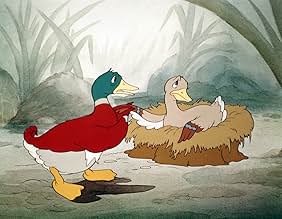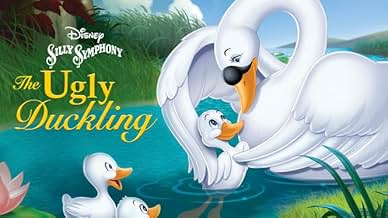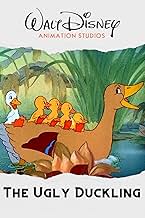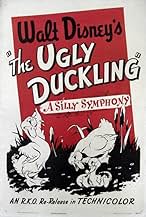VALUTAZIONE IMDb
7,6/10
3930
LA TUA VALUTAZIONE
Un piccolo anatroccolo è ignorato dalla sua famiglia e da tutti gli altri animali ed uccelli perchè è diverso, finchè una mamma cigno decide di adottarlo e crescerlo come se fosse uno dei su... Leggi tuttoUn piccolo anatroccolo è ignorato dalla sua famiglia e da tutti gli altri animali ed uccelli perchè è diverso, finchè una mamma cigno decide di adottarlo e crescerlo come se fosse uno dei suoi figli.Un piccolo anatroccolo è ignorato dalla sua famiglia e da tutti gli altri animali ed uccelli perchè è diverso, finchè una mamma cigno decide di adottarlo e crescerlo come se fosse uno dei suoi figli.
- Regia
- Sceneggiatura
- Star
- Vincitore di 1 Oscar
- 1 vittoria in totale
Amanda Cewel
- Mother Duck (speaking)
- (non citato nei titoli originali)
Tom Cotry
- Father Duck (speaking)
- (non citato nei titoli originali)
Recensioni in evidenza
Genre: Disney short, based on Hans Christian Anderson tale.
Main characters: The ugly duckling, the duck and the swan.
What happens: A father duck has managed to "dig" a ditch by walking around impatiently, waiting for his ducklings to hatch out of their eggs. Finally, this happens, but an unexpected egg also hatches, one with an "ugly duckling"
Message: Often differences can be good.
My thoughts: Growing up with this short, this is a very cute Silly Symphony, one of many that Walt Disney created. This particular one I love dearly, as I do with most of the ones I have watched. It is very lovable and also very emotional (at points I nearly cry). You will understand this sadness whether you know the Hans Christian Anderson tale or not, it melts your heart (well mine anyway). I cannot understand people who are at least SLIGHTLY moved by something in this short. I like the character of the ugly duckling, he is lovable at first sight. If a family is watching this (and the children are between 0 and 7) you may want to be a little cautious so as not to upset the youngest. I was certainly upset when I was little, but thankfully that has changed, as sadness has also turned into love for this cartoon. I hope you are as warmed just as much as I was.
Recommended to: Children who like cartoons and adults who like cartoons. Enjoy! :-)
Main characters: The ugly duckling, the duck and the swan.
What happens: A father duck has managed to "dig" a ditch by walking around impatiently, waiting for his ducklings to hatch out of their eggs. Finally, this happens, but an unexpected egg also hatches, one with an "ugly duckling"
Message: Often differences can be good.
My thoughts: Growing up with this short, this is a very cute Silly Symphony, one of many that Walt Disney created. This particular one I love dearly, as I do with most of the ones I have watched. It is very lovable and also very emotional (at points I nearly cry). You will understand this sadness whether you know the Hans Christian Anderson tale or not, it melts your heart (well mine anyway). I cannot understand people who are at least SLIGHTLY moved by something in this short. I like the character of the ugly duckling, he is lovable at first sight. If a family is watching this (and the children are between 0 and 7) you may want to be a little cautious so as not to upset the youngest. I was certainly upset when I was little, but thankfully that has changed, as sadness has also turned into love for this cartoon. I hope you are as warmed just as much as I was.
Recommended to: Children who like cartoons and adults who like cartoons. Enjoy! :-)
For ten years, Walt Disney's talented animators pumped out cartoon after cartoon for his 'Silly Symphonies.' Walt decided it was time to shut down one of animation's most successful series. The final film of the 'Silly Symphonies' was April 1939's "The Ugly Duckling." The series went out with a bang, with the duck short winning the Academy Award for Best Short Subject (Cartoon), the 'Silly Symphonies' eighth Oscar win. The 75-cartoon series proved to be an invaluable testing ground for Disney to create and test new techniques and technologies, resulting in Walt's first feature film, 1938's "Snow White and the Seven Dwarfs."
Disney's animators, led by Jack Cutting and Ham Luske, had completed Hans Christian Andersen's fairy tale cartoon the year before. But Walt elected to hold off its release until he secured a Radio City Music Hall premier during the Easter Week which happened to front-end Fred Astaire and Ginger Rogers' "The Story of Vernon and Irene Castle." The 1939 version of "The Ugly Duckling" was his second telling of the 1843 Andersen story about a newly hatched white duckling who clearly didn't belong to the brood of baby mallard ducks the mother had just delivered. The most recent version was much sadder than its 1931 black-and-white predecessor, which played up the humorous aspects of the tale. But the Oscar-winning 1939 cartoon's ending was more in line with the written Andersen work than the earlier one.
"The Ugly Duckling" of 1939 concluded the 'Silly Symphonies'' storied series beginning in 1929 with "The Skeleton Dance." The string of successive cartoons was intended to be a platform for mainly musically-based animations with very little yapping. Over the course of its ten-year lifespan, the symphonies introduced a variety of innovations in animation, including the first three-strip Technicolor cartoon in 1932's "Flowers and Trees," special effects, more realistic human and animal movements, the multi-plane camera, and on and on. Only the cartoon series 'Tom and Jerry' would achieve the number of Academy Award wins as the 'Silly Symphonies.' After the overwhelming success of "Snow White," Walt decided to concentrate on his ambitious full-length films and his Mickey Mouse shorts. Some say the spirit of the series was carried on by his all-musical animated feature film, 1941's "Fantasia."
Disney's animators, led by Jack Cutting and Ham Luske, had completed Hans Christian Andersen's fairy tale cartoon the year before. But Walt elected to hold off its release until he secured a Radio City Music Hall premier during the Easter Week which happened to front-end Fred Astaire and Ginger Rogers' "The Story of Vernon and Irene Castle." The 1939 version of "The Ugly Duckling" was his second telling of the 1843 Andersen story about a newly hatched white duckling who clearly didn't belong to the brood of baby mallard ducks the mother had just delivered. The most recent version was much sadder than its 1931 black-and-white predecessor, which played up the humorous aspects of the tale. But the Oscar-winning 1939 cartoon's ending was more in line with the written Andersen work than the earlier one.
"The Ugly Duckling" of 1939 concluded the 'Silly Symphonies'' storied series beginning in 1929 with "The Skeleton Dance." The string of successive cartoons was intended to be a platform for mainly musically-based animations with very little yapping. Over the course of its ten-year lifespan, the symphonies introduced a variety of innovations in animation, including the first three-strip Technicolor cartoon in 1932's "Flowers and Trees," special effects, more realistic human and animal movements, the multi-plane camera, and on and on. Only the cartoon series 'Tom and Jerry' would achieve the number of Academy Award wins as the 'Silly Symphonies.' After the overwhelming success of "Snow White," Walt decided to concentrate on his ambitious full-length films and his Mickey Mouse shorts. Some say the spirit of the series was carried on by his all-musical animated feature film, 1941's "Fantasia."
A Walt Disney SILLY SYMPHONY Cartoon Short.
A gawky UGLY DUCKLING, only moments after birth, is hectored & harried from the family of ducks he was born into. Will he ever find happiness & learn his true destiny?
This is a pleasant cartoon, with the plucky personality of the protagonist firmly front & center; the by-play between the duck parents is also amusing. Based on the Hans Christian Andersen classic, it is a remake of a 1931 black & white Symphony. The SILLY SYMPHONIES ended with this film, but they went out with a bang - like 6 of its predecessors, THE UGLY DUCKLING was awarded an Oscar for Best Animation.
The SILLY SYMPHONIES, which Walt Disney produced for a ten year period beginning in 1929, are among the most fascinating of all animated series. Unlike the Mickey Mouse cartoons in which action was paramount, with the Symphonies the action was made to fit the music. There was little plot in the early Symphonies, which featured lively inanimate objects and anthropomorphic plants & animals, all moving frantically to the soundtrack. Gradually, however, the Symphonies became the school where Walt's animators learned to work with color and began to experiment with plot, characterization & photographic special effects. The pages of Fable & Fairy Tale, Myth & Mother Goose were all mined to provide story lines and even Hollywood's musicals & celebrities were effectively spoofed. It was from this rich soil that Disney's feature-length animation was to spring. In 1939, with SNOW WHITE successfully behind him and PINOCCHIO & FANTASIA on the near horizon, Walt phased out the SILLY SYMPHONIES; they had run their course & served their purpose.
A gawky UGLY DUCKLING, only moments after birth, is hectored & harried from the family of ducks he was born into. Will he ever find happiness & learn his true destiny?
This is a pleasant cartoon, with the plucky personality of the protagonist firmly front & center; the by-play between the duck parents is also amusing. Based on the Hans Christian Andersen classic, it is a remake of a 1931 black & white Symphony. The SILLY SYMPHONIES ended with this film, but they went out with a bang - like 6 of its predecessors, THE UGLY DUCKLING was awarded an Oscar for Best Animation.
The SILLY SYMPHONIES, which Walt Disney produced for a ten year period beginning in 1929, are among the most fascinating of all animated series. Unlike the Mickey Mouse cartoons in which action was paramount, with the Symphonies the action was made to fit the music. There was little plot in the early Symphonies, which featured lively inanimate objects and anthropomorphic plants & animals, all moving frantically to the soundtrack. Gradually, however, the Symphonies became the school where Walt's animators learned to work with color and began to experiment with plot, characterization & photographic special effects. The pages of Fable & Fairy Tale, Myth & Mother Goose were all mined to provide story lines and even Hollywood's musicals & celebrities were effectively spoofed. It was from this rich soil that Disney's feature-length animation was to spring. In 1939, with SNOW WHITE successfully behind him and PINOCCHIO & FANTASIA on the near horizon, Walt phased out the SILLY SYMPHONIES; they had run their course & served their purpose.
The only reason I give this film a 9 and not a 10 is that it's actually a remake of a film this same studio made eight years earlier. I tend to be a little tougher on remakes plus it just doesn't take nearly as much effort to remake a film instead of do one from scratch. However, despite this concern, I can see why this film received the Oscar for Best Animated Short. It is simply wonderful from start to finish.
First, the animation is exactly what you'd expect from Disney from this era. In the 1930s, no other studio came close in quality of animation and music. The whole package was simply terrific and could not be beat. I particularly loved the wonderful backgrounds as well as the great use of colors--nicely muted and soft.
Second, the story, while very familiar to most, is wonderful. I am not ashamed to admit that by the end of the film, my eyes were very misty--it is a lovely and sentimental film. A joy to watch from start to finish.
First, the animation is exactly what you'd expect from Disney from this era. In the 1930s, no other studio came close in quality of animation and music. The whole package was simply terrific and could not be beat. I particularly loved the wonderful backgrounds as well as the great use of colors--nicely muted and soft.
Second, the story, while very familiar to most, is wonderful. I am not ashamed to admit that by the end of the film, my eyes were very misty--it is a lovely and sentimental film. A joy to watch from start to finish.
The last of the "Silly Symphonies","The Ugly Duckling" demonstrates the heights that Walt Disney and his artists had reached by the late 1930s and early 1940s. In just eight or nine minutes, and without a word of dialogue, we are presented with Hans Andersen's wistful fairy-tale. Exquisite drawings by animators including Milt Kahl and Eric Larson (both of whom would provide major contributions to the feature-length "Bambi")and lush watercolour layouts by David Hilberman combine with elegant camera movement and a lilting score by Albert Hay Malotte to create a miniature jewel of animation. The scene where the little duckling plays affectionately with the wooden decoy duck because it is the only thing in the world not to reject it, is one of the saddest in all cinema. The great Warner Bros animator Chuck Jones acclaimed "The Ugly Duckling" as one of the greatest short subjects ever made - and indeed, it is.
Lo sapevi?
- QuizThe last Silly Symphony cartoon. Also, the only one to be a remake (of L'anitroccolo eroico (1931)).
- BlooperWhen the hero is reunited with his family, we discover that he is one of five baby swans. However, for a brief moment, six baby swans appear on screen as they swim around one another before returning to their mother.
- ConnessioniFeatured in Disneyland: From Aesop to Hans Christian Andersen (1955)
- Colonne sonoreBorn to Ugly Duckling
(uncredited)
Traditional
Performed by studio orchestra
I più visti
Accedi per valutare e creare un elenco di titoli salvati per ottenere consigli personalizzati
Dettagli
- Data di uscita
- Paese di origine
- Sito ufficiale
- Lingua
- Celebre anche come
- Il piccolo diseredato
- Azienda produttrice
- Vedi altri crediti dell’azienda su IMDbPro
- Tempo di esecuzione9 minuti
- Proporzioni
- 1.37 : 1
Contribuisci a questa pagina
Suggerisci una modifica o aggiungi i contenuti mancanti

Divario superiore
By what name was Il brutto anatroccolo (1939) officially released in Canada in English?
Rispondi




















